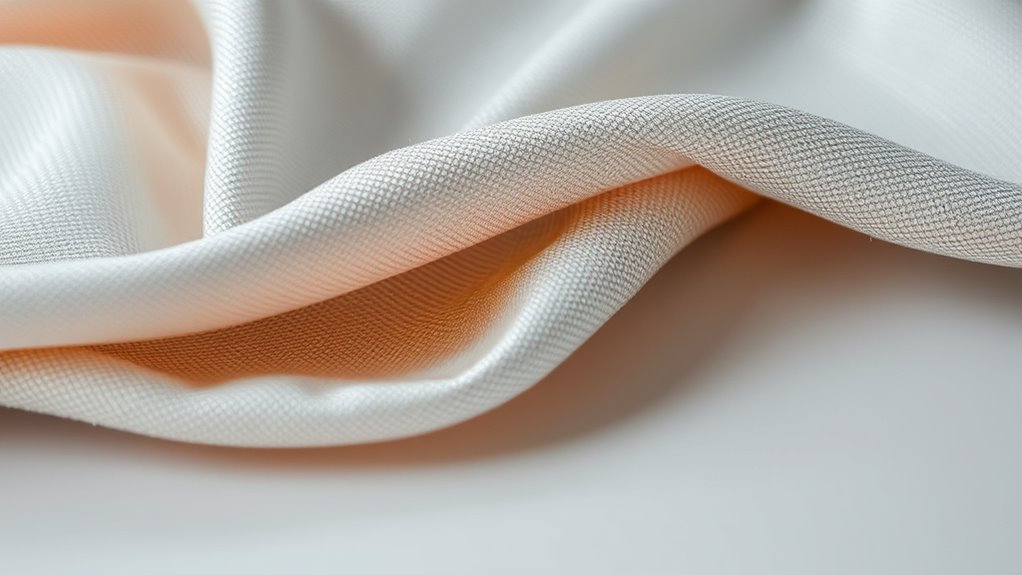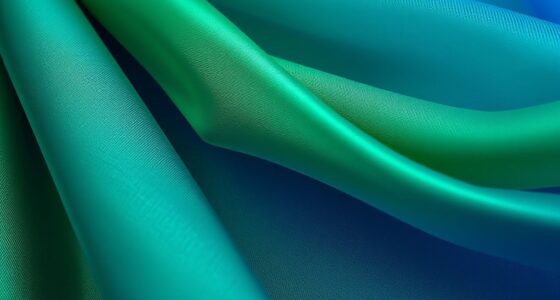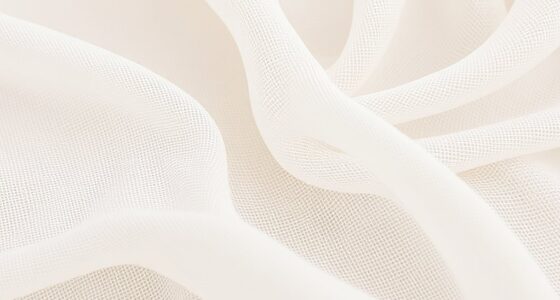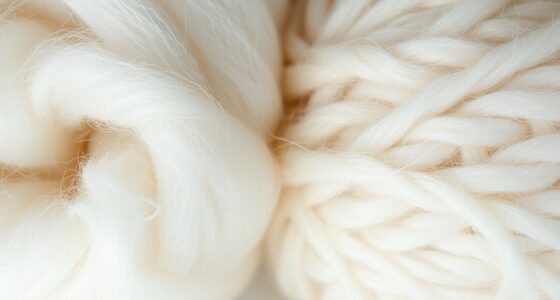Antimicrobial fabrics infused with silver, copper, or bamboo kill germs by disrupting microbial cells and preventing their growth on textiles. Silver and copper ions actively attack bacteria and fungi, while bamboo fibers contain natural anti-microbial properties. These materials not only keep fabrics fresher longer but also help reduce odors and spread of illnesses. To discover more about how these materials work and their benefits, keep exploring this fascinating topic.
Key Takeaways
- Silver ions disrupt microbial cell functions, leading to the death of bacteria, fungi, and viruses on fabric surfaces.
- Copper releases ions that generate oxidative stress, damaging microbial cell membranes and DNA, killing germs effectively.
- Bamboo fibers contain natural antimicrobial compounds that inhibit microbial growth, providing inherent germ-fighting properties.
- Silver and copper ions gradually release from fabrics, continuously killing germs and reducing odors over time.
- Proper manufacturing and treatment methods enhance the antimicrobial efficacy of fabrics made from silver, copper, or bamboo.
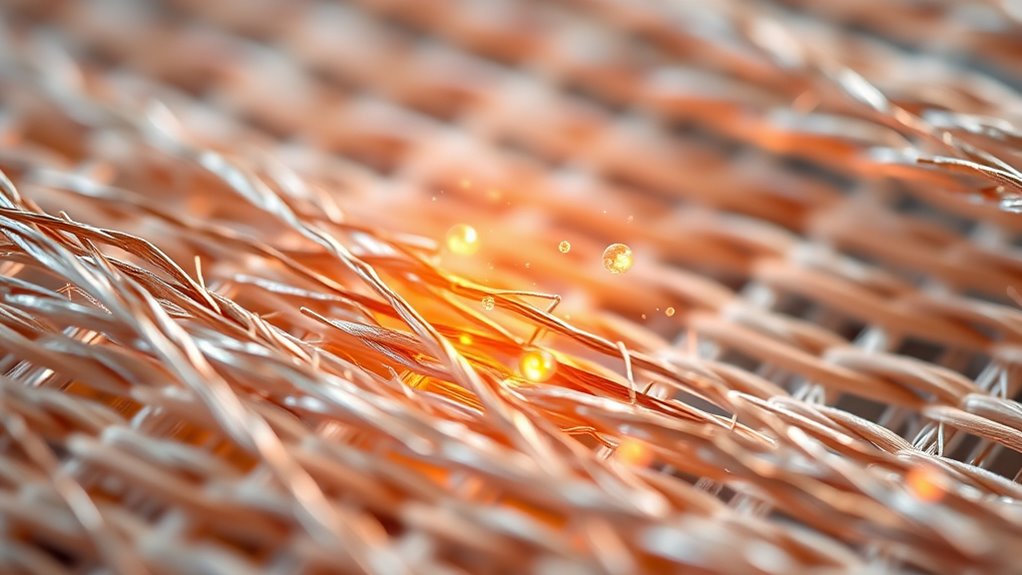
Have you ever wondered how fabrics can help fight germs and bacteria? It’s a fascinating topic, especially when you consider the role of antimicrobial fabrics woven with silver, copper, or bamboo. These materials aren’t just about keeping your clothes fresh; they actively combat microbes, reducing odors and the spread of illnesses. But beyond their germ-fighting abilities, it’s important to understand how they perform in *regards to* fabric durability and environmental impact. These factors determine how well the fabrics hold up over time and how sustainable they are for the planet.
When it comes to fabric durability, antimicrobial treatments or inherent properties of materials like silver and copper tend to enhance the lifespan of textiles. Fabrics infused with these metals resist the growth of bacteria and fungi that typically cause odors, stains, and fabric degradation. This means you won’t need to wash these items as frequently or replace them as often, making them a practical choice for everyday wear or high-use items like medical textiles. Plus, since they resist microbial growth, the fabrics stay fresher longer, reducing the wear and tear caused by repeated washing. This extended durability not only saves you money but also means fewer textiles end up in landfills, which is a positive for the environment. Additionally, ongoing research into antimicrobial fabric coatings is helping improve their effectiveness and safety for consumers.
Speaking of the environment, the environmental impact of antimicrobial fabrics varies depending on the materials and manufacturing processes involved. Silver, for example, is a powerful antimicrobial agent, but its mining and disposal can pose ecological concerns. Copper, while also effective, is generally less environmentally taxing to produce. Bamboo fabrics are often touted as eco-friendly because bamboo is a rapidly renewable resource that requires minimal water and chemicals to grow. However, the processing methods used to turn bamboo into fabric can involve chemical-intensive steps, which might affect their overall sustainability. When you choose antimicrobial fabrics, it’s worth considering how their production impacts the environment—opting for products made with eco-conscious practices can help minimize negative effects.
Frequently Asked Questions
How Long Do Antimicrobial Properties Last on Fabrics?
The antimicrobial properties on fabrics typically last between 20 to 50 wash cycles, depending on the treatment durability. You can expect the fabric’s longevity to decline gradually with use and washing. To maximize antimicrobial effectiveness, follow care instructions carefully, as harsh detergents or high heat can diminish these properties faster. Proper maintenance guarantees your fabric remains germ-resistant for as long as possible, providing ongoing protection.
Are Antimicrobial Fabrics Safe for Sensitive Skin?
Yes, antimicrobial fabrics are generally safe for sensitive skin, but you should still be cautious. If you have skin sensitivity or allergy concerns, check the fabric’s ingredients and testing information. Some people might experience irritation from metals like silver or copper, so look for hypoallergenic options. Always do a patch test first, and consult your dermatologist if you’re unsure. Your comfort and safety should come first.
Can Antimicrobial Fabrics Prevent All Types of Bacteria?
You might think antimicrobial fabrics prevent all bacteria, but they don’t eliminate every single germ. While they effectively reduce surface contamination and resist common bacteria, no fabric can prevent all types. Their durability ensures long-lasting protection, but some bacteria may still survive in cracks or on untreated surfaces. So, while helpful, antimicrobial fabrics are a strong defense, not a complete shield against all germs.
Do Antimicrobial Treatments Wash Out Over Time?
You’ll find that antimicrobial treatments can wash out over time, affecting fabric longevity and washing durability. Regular washing, especially with harsh detergents or high temperatures, gradually diminishes their effectiveness. To keep your antimicrobial fabrics working properly, follow care instructions carefully and opt for gentle washing methods. While treatments do fade, proper maintenance helps extend their germ-fighting properties, ensuring your fabric remains effective longer.
Are Antimicrobial Fabrics Environmentally Friendly?
You might wonder if antimicrobial fabrics are eco-friendly. Many are produced with eco-friendly manufacturing processes and use biodegradable options, making them a better choice for the environment. These fabrics reduce the need for chemical cleaning and washing, which lowers water and energy consumption. Look for products labeled as biodegradable or made with sustainable practices to guarantee you’re choosing environmentally responsible antimicrobial fabrics that support eco-conscious living.
Conclusion
Now that you know how silver, copper, and bamboo fight germs, you can make smarter choices for your health. These fabrics act like a modern-day knight, defending you from harmful microbes just as a trusty shield would in a medieval tale. Embrace this fusion of ancient wisdom and cutting-edge science—your armor against germs is more powerful than ever. Stay vigilant and remember, in the battle against bacteria, knowledge is your greatest weapon.
